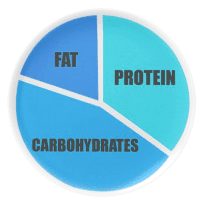News
Macronutrients, and you…
What Are Macronutrients?
Macronutrients are defined as any of the nutritional components of the diet that are required in relatively large amounts. Simply, macronutrients are broken down into Protein, Carbohydrates and Fat.
Protein – Dietary Protein has 4 calories per gram and contains essential Amino Acids that are responsible for tissue repair and growth.
Carbohydrates – Carbohydrates have 4 calories per gram and are the bodies preferred energy source.
Fat – Dietary Fat has 9 calories per gram and is responsible for optimal hormone production as well as aiding the absorption of nutrients.
The total combined calories of these macronutrients determine the energy entering your body throughout the day. For E.g. –
120g Protein (480 calories) + 200g Carbohydrates (800 calories) + 60g Fat = (540 calories) = 1820 calories
How does this help me?
Now that we know what macronutrients are and what they are used for, how do we use this to our advantage?
It’s reasonably straight forward, we count the macronutrients (calories) entering our body and we manipulate them. Either by eating at a deficit or eating in a surplus.
The concept of eating in a deficit or surplus is purely an imbalance of energy either resulting in Fat Loss, or Muscle Gain with Minimal Fat Gain (if done correctly). This is only achievable if you first determine how much food you need to consume to remain the same weight. Or in other words, your Maintenance Level
This is where it gets slightly technical, to make things easier I’ve Included a table for easy reading. The example provided is for a female who is moderately active, that weighs 65kg.
*These are only guidelines to help estimate your maintenance calories, tweaking will be necessary*
| Activity Level | Low (less than 2 hours of vigorous exercise per week) | Moderate (approx. 4 hours of vigorous exercise per week) | High (more than 4 hours of vigorous exercise per week) |
| Activity Multiplier | 27 | 29 | 31 |
| Bodyweight (Kg) | --- | 65kg | --- |
| Calories | --- | 1885 Calories | --- |
| Activity Level | Low (less than 2 hours of vigorous exercise per week) | Moderate (approx. 4 hours of vigorous exercise per week) | High (more than 4 hours of vigorous exercise per week) |
| Activity Multiplier | 29 | 31 | 33 |
| Bodyweight (Kg) | --- | --- | --- |
| Calories | --- | --- | --- |
The formula to find your Maintenance Level is as follows;
Activity Multiplier x Bodyweight (Kg) = Maintenance Level
29 x 65kg = 1885 calories
Therefore, the example females Maintenance Level is 1885 calories per day.
What macronutrient breakdown should I use?
We recommend the following as a guideline for acquiring an optimal macronutrient breakdown.
Protein; 1.6–2.5g per kilogram of body weight
Fat; 08–1.2g per kilogram of body weight
Carbohydrates; Remainder of total calories divided by 4, after protein and fats have been calculated
In this case the optimal macronutrient breakdown the for 65kg female is as follows;
*Protein and Fat intake is averaged as being both 2g Protein and 1g Fat per Kilo per day respectively*
Protein; 2g x 65 = 130g protein per day (540 calories)
Fat; 1g x 65 = 65g fat per day (585 calories)
Carbohydrates; Maintenance level (1885) – Protein (540) + Fat (585) = 190g carbohydrates per day (760 calories)
Manipulating this information for optimal Body Composition
Okay, now this is the easy part. We know what macronutrients are, we know how many calories we should eat in a day and what macronutrient breakdown we should follow. Now we adjust them for our goals.
For the remainder of the article I’m going to concentrate on Fat Loss, which means eating less than your maintenance level. This is can be done slowly or if necessary, drastically. we’d generally recommend that you decrease your maintenance calories by 10%, adjusting accordingly to rate of weight loss.
Maintenance Level (1885) x 0.9 (deficit) = 1697 calories per day
If you’re not losing weight at a reasonable rate you can either decrease your calories by 10% more, increase your training volume while keeping calories the same, or a combination of the two previous recommendations. A good rule of thumb is to lose 0.005 – 0.010% of your body weight per week. In this case rate of Fat Loss should be between 325 – 650g of fat per week, any more than this may result in unnecessary muscle loss.
What if I don’t lose any weight in the week?
Don’t stress, weight loss can be affected by many factors. These being;
- Meal timing
- Hormonal cycle
- Hydration levels
- Sodium balance
Stick to the plan, stay consistent and be honest with yourself. Did you follow the plan correctly? Did I track all my food accurately? Did I binge on Saturday night and ‘forget’ to include this into my daily calories?
A great way to keep yourself accountable is to download MyFitnessPal. This application helps you track the macronutrients you eat per day, making it an effortless means of tracking your Protein Carbohydrate and Fat intake per day.
Wrapping it all up
Although we’ve only touched on the very basic points of macronutrients and the ability to manipulate them for your optimal body composition, We hope this sheds some light on the ongoing war of every gym member. Fat Loss or Muscle Gain.
We at Amp’d Fitness are always willing to help any member better themselves. if you have any questions, feel free to ask our team. We would be more than happy to point you in the right direction to achieve your goals!

